The Outdoor LED Lighting Market is estimated to be valued at USD 15.0 billion in 2025 and is projected to reach USD 28.0 billion by 2035, registering a compound annual growth rate (CAGR) of 6.5% over the forecast period.
The outdoor LED lighting market is growing steadily, supported by global initiatives for energy efficiency, urban beautification, and infrastructure modernization. The transition from conventional lighting to LED-based systems is being driven by lower power consumption, extended lifespan, and reduced maintenance requirements. Municipal authorities and private developers are prioritizing smart lighting solutions integrated with motion sensors, wireless controls, and adaptive brightness systems.
Increased adoption in roadways, architectural lighting, and public spaces is enhancing safety and aesthetic appeal while meeting sustainability goals. Favorable government policies promoting green infrastructure and smart city projects continue to strengthen market expansion.
With technological innovations in optics and thermal management, LED luminaires are expected to remain the standard for outdoor illumination. The market outlook remains positive, fueled by continuous replacement demand and large-scale deployment across urban and suburban regions..
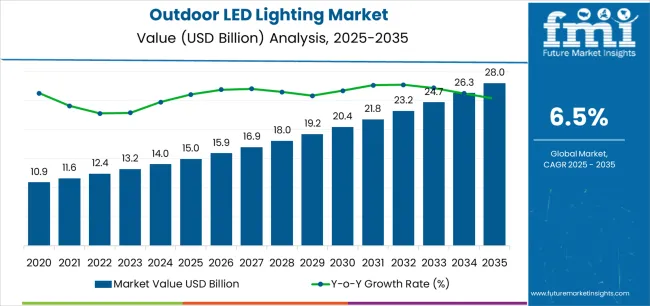
| Metric | Value |
|---|---|
| Outdoor LED Lighting Market Estimated Value in (2025 E) | USD 15.0 billion |
| Outdoor LED Lighting Market Forecast Value in (2035 F) | USD 28.0 billion |
| Forecast CAGR (2025 to 2035) | 6.5% |
The market is segmented by Offering, Application, Installation, Sales Channel, Wattage Type, Communication, and Interfacing Standard and region. By Offering, the market is divided into Luminaires, Hardware, Software, and Services. In terms of Application, the market is classified into Streets And Roads, Architecture And Urban Landscape, Sports And Large Area, Tunnels, and Others. Based on Installation, the market is segmented into New and Retrofit. By Sales Channel, the market is divided into Direct Sales, Retail/Wholesale, and E-commerce. By Wattage Type, the market is segmented into 50-150W, Below 50W, and Above 150W. By Communication, the market is segmented into Wired and Wireless. By Interfacing Standard, the market is segmented into NEMA and ZHAGA. Regionally, the market is classified into North America, Latin America, Western Europe, Eastern Europe, Balkan & Baltic Countries, Russia & Belarus, Central Asia, East Asia, South Asia & Pacific, and the Middle East & Africa.
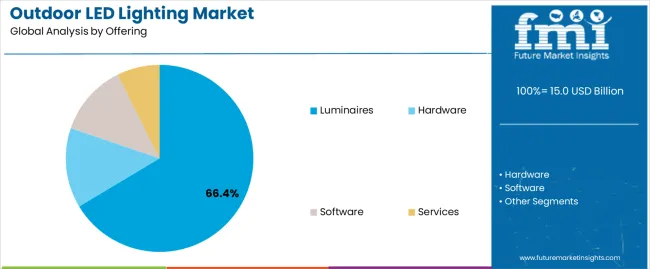
The luminaires segment dominates the offering category with approximately 66.4% share, supported by widespread adoption in municipal, commercial, and architectural applications. Integrated LED luminaires provide higher efficiency, superior light distribution, and improved design flexibility compared to retrofit lamps.
The segment’s growth is reinforced by cost competitiveness and advancements in modular designs that simplify installation and maintenance. Urban lighting projects, particularly those aligned with smart city initiatives, are increasingly specifying integrated luminaires due to their compatibility with control systems and long-term reliability.
Continuous innovation in materials and optics has enhanced performance in challenging outdoor environments. With global infrastructure investment and public sector emphasis on energy-efficient lighting, the luminaires segment is anticipated to retain its leadership throughout the forecast period..
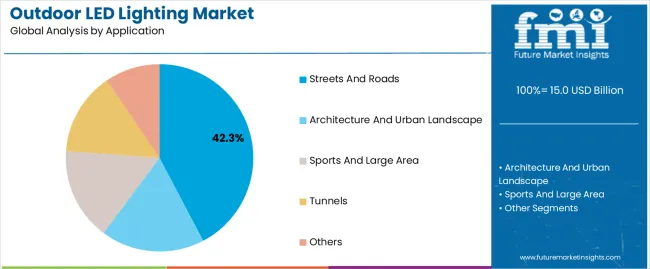
The streets and roads segment leads the application category with approximately 42.3% share, driven by the large-scale replacement of traditional sodium vapor and halogen lamps. Municipal authorities are adopting LED systems to reduce energy expenditure and improve public safety through consistent illumination.
The segment benefits from government-funded modernization programs and the integration of smart controls enabling adaptive brightness and motion-based operation. Extended operational life and minimal maintenance requirements further enhance cost-effectiveness, making LED technology the preferred choice for road networks.
The growing trend of connected lighting infrastructure for traffic management and surveillance also supports segment growth. With expanding urbanization and focus on sustainable lighting solutions, the streets and roads segment is expected to maintain strong momentum..
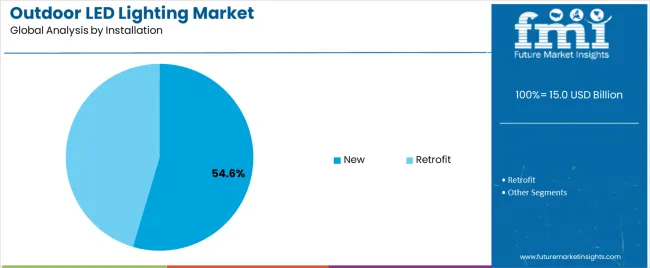
The new installation segment holds approximately 54.6% share in the installation category, reflecting the growing number of greenfield projects and urban expansion activities worldwide. Infrastructure development initiatives, including highways, industrial zones, and residential complexes, are driving demand for newly installed outdoor LED systems.
Project developers increasingly favor LED lighting for its long-term operational savings and environmental compliance. The segment’s growth is also supported by the ease of integration with modern control architectures in new infrastructure layouts.
Emerging economies investing in large-scale public lighting installations contribute significantly to demand. With continuous urban development and sustainability-focused construction policies, the new installation segment is projected to sustain its dominant position during the forecast period..
The scope for global outdoor LED lighting market insights expanded at a 9.7% CAGR between 2020 and 2025. The market is anticipated to develop at a CAGR of 6.8% over the forecast period from 2025 to 2035.
| Historical CAGR from 2020 to 2025 | 9.7% |
|---|---|
| Forecast CAGR from 2025 to 2035 | 6.8% |
Between 2020 and 2025, the global market witnessed robust growth, expanding at a CAGR of 9.7%. This growth was driven by several factors, including increasing awareness of energy efficiency, government initiatives promoting LED adoption, and the growing trend towards smart city infrastructure. Advancements in LED technology, such as improved brightness and durability, contributed to market expansion during this period.
The market is expected to develop at a slightly lower CAGR of 6.8% from 2025 to 2035. This projected growth rate reflects several factors, including market maturity in some regions, saturation in certain application segments, and pricing pressures.
As LED technology becomes more widespread and mainstream, the pace of growth may moderate compared to the earlier years. Nonetheless, factors such as ongoing urbanization, infrastructure development projects, and the increasing emphasis on sustainability are expected to continue driving demand for outdoor LED lighting solutions throughout the forecast period.
| Attributes | Details |
|---|---|
| Opportunities |
|
The table highlights the CAGRs across five crucial countries, the United States, Japan, China, the United Kingdom, and South Korea. South Korea stands out as a dynamic market, projected to achieve significant growth with an impressive 9.3% CAGR by 2035.
Renowned for its dedication to innovation, the country is a pivotal player across various industries, showcasing a thriving economic landscape characterized by continuous progress.
The substantial CAGR underscores a proactive approach to embracing and driving advancements in the market, solidifying its position as a key contributor to the global industry. This reflects the commitment to sustainable practices, positioning South Korea as a notable player driving positive developments within the outdoor LED lighting sector on a global scale.
| Countries | CAGRs from 2025 to 2035 |
|---|---|
| The United States | 6.9% |
| Japan | 8% |
| China | 7.4% |
| The United Kingdom | 7.2% |
| South Korea | 9.3% |
The widespread adoption of outdoor LED lighting in the United States can be attributed to several factors. Firstly, stringent regulations and energy efficiency initiatives drive the demand for LED solutions.
The vast urban and suburban areas necessitate efficient and long-lasting lighting options, making LED technology a preferred choice. The mature infrastructure and established market for lighting products facilitate the adoption of LED systems across various applications, including street lighting, parking lots, and architectural illumination.
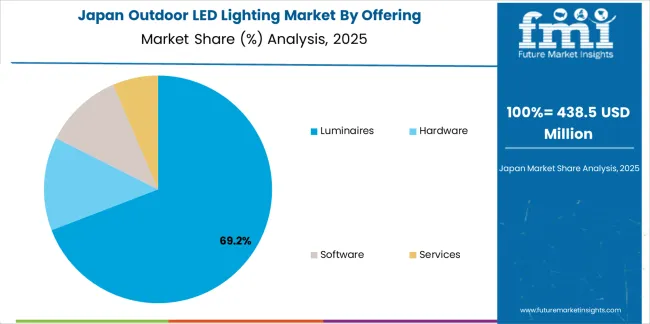
In Japan, where space is limited and environmental sustainability is a priority, outdoor LED lighting offers an efficient solution. The commitment to innovation and technological advancement aligns well with the benefits offered by LED technology, such as energy efficiency and long lifespan.
The emphasis on urban planning and aesthetics further drives the adoption of LED lighting for streets, parks, and public spaces.
Rapid urbanization and environmental concerns in China have propelled the demand for outdoor LED lighting. The governmental push for energy conservation and reducing carbon emissions has LED to the widespread adoption of LED solutions in cities and urban areas.
The manufacturing prowess has made LED lighting products more affordable and accessible, boosting their usage across various outdoor applications.
In the United Kingdom, stringent regulations to reduce energy consumption and carbon emissions drive the adoption of outdoor LED lighting. The focus on sustainable development and green initiatives aligns well with LED technologies' energy-efficient and environmentally friendly attributes.
The commitment of the United Kingdom to smart city initiatives and infrastructure upgrades further accelerates the adoption of LED lighting solutions for streets, public spaces, and commercial areas.
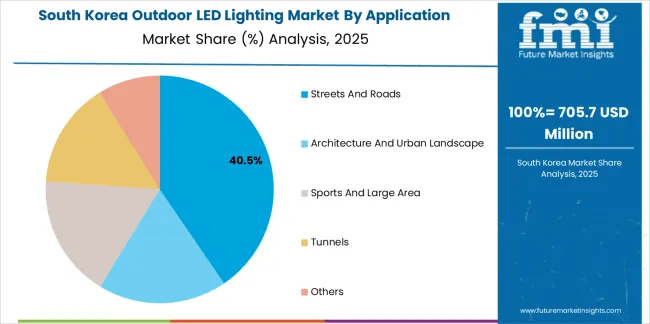
In South Korea, renowned for its technological advancements and commitment to innovation, outdoor LED lighting is widely embraced for its energy efficiency and performance. The dense urban areas and focus on urban beautification drive the demand for high-quality lighting solutions.
The strong emphasis on sustainability and smart city initiatives further propels the adoption of LED lighting across various outdoor applications, positioning it as a leading market for outdoor LED lighting solutions.
The table below provides an overview of the outdoor LED lighting landscape on the basis of offering and application. Hardware is projected to lead the market offering at a 6.5% CAGR by 2035, while streets and roads in the application category are likely to expand at a CAGR of 6.4% by 2035.
Advancements in LED technology, lighting controls, and related hardware components drive market growth by offering improved efficiency, durability, and functionality, thus propelling hardware to lead the market offering.
Rapid urbanization and ongoing infrastructure development projects worldwide increase the demand for efficient and reliable outdoor lighting solutions, particularly for streets and roads, to ensure safety, visibility, and enhanced aesthetics in urban and rural areas.
| Category | CAGRs from 2025 to 2035 |
|---|---|
| Hardware | 6.5% |
| Streets and Roads | 6.4% |
The outdoor LED lighting landscape is segmented based on offerings and applications, with hardware projected to lead the market at a CAGR of 6.5% by 2035.
Hardware components include LED fixtures, lighting controls, and related accessories, driving market growth through their essential role in outdoor lighting systems. This projection underscores the sustained demand for reliable and energy-efficient hardware solutions across various outdoor lighting applications.
Streets and roads are expected to significantly expand within the application category, with a projected CAGR of 6.4% by 2035. This growth is driven by the increasing need for efficient and durable lighting solutions to illuminate urban and rural roadways, highways, and thoroughfares.
Factors such as urbanization, infrastructure development, and safety concerns contribute to the rising demand for outdoor LED lighting in streets and roads, highlighting the importance of reliable illumination for enhanced visibility and safety for pedestrians and motorists alike.
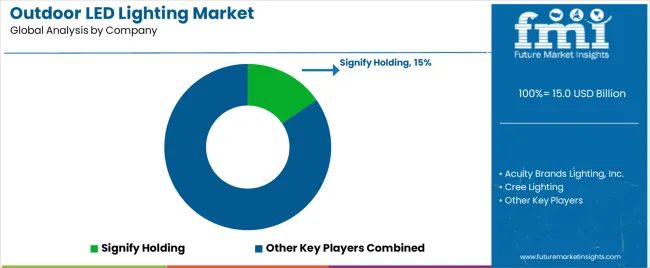
In the competitive landscape of the outdoor LED lighting market, several key players vie for market share and dominance. These companies range from established lighting manufacturers to specialized LED lighting solution providers.
Technological innovation, product quality, pricing strategies, distribution networks, and customer service characterize competition in this market.
Major players in the market often offer products catering to various outdoor lighting applications, including street, landscape, architectural, and security lighting. These companies invest significantly in research and development to introduce advanced features such as energy efficiency, durability, and smart lighting controls.
Strategic partnerships and collaborations with urban planners, architects, and government agencies play a crucial role in expanding market presence and driving innovation. Companies often use mergers and acquisitions to strengthen their product portfolios and expand into new markets.
Key Market Developments
| Attributes | Details |
|---|---|
| Estimated Market Size in 2025 | USD 14 billion |
| Projected Market Valuation in 2035 | USD 27 billion |
| CAGR Share from 2025 to 2035 | 6.8% |
| Forecast Period | 2025 to 2035 |
| Historical Data Available for | 2020 to 2025 |
| Market Analysis | Value in USD billion |
| Key Regions Covered | North America; Latin America; Western Europe; Eastern Europe; South Asia and Pacific; East Asia; Middle East and Africa |
| Key Market Segments Covered | Offering, Application, Installation, Sales Channel, Wattage Type, Communication, Interfacing Standard, Region |
| Key Countries Profiled | The United States, Canada, Brazil, Mexico, Germany, The United Kingdom, France, Spain, Italy, Poland, Russia, Czech Republic, Romania, India, Bangladesh, Australia, New Zealand, China, Japan, South Korea, GCC Countries, South Africa, Israel |
| Key Companies Profiled | Signify Holding; Acuity Brands Lighting Inc.; Cree Lighting; Dialight; Panasonic Corporation |
The global outdoor LED lighting market is estimated to be valued at USD 15.0 billion in 2025.
The market size for the outdoor LED lighting market is projected to reach USD 28.0 billion by 2035.
The outdoor LED lighting market is expected to grow at a 6.5% CAGR between 2025 and 2035.
The key product types in outdoor LED lighting market are luminaires, hardware, _lamps, _control systems, software, services, _pre-installation and _post-installation.
In terms of application, streets and roads segment to command 42.3% share in the outdoor LED lighting market in 2025.






Full Research Suite comprises of:
Market outlook & trends analysis
Interviews & case studies
Strategic recommendations
Vendor profiles & capabilities analysis
5-year forecasts
8 regions and 60+ country-level data splits
Market segment data splits
12 months of continuous data updates
DELIVERED AS:
PDF EXCEL ONLINE
Outdoor Boundary Vacuum Load Switch Market Size and Share Forecast Outlook 2025 to 2035
Outdoor Payment Terminal Market Size and Share Forecast Outlook 2025 to 2035
Outdoor Commercial Grills Market Size and Share Forecast Outlook 2025 to 2035
Outdoor Kitchen Appliances Market Size and Share Forecast Outlook 2025 to 2035
Outdoor Furniture Market Size and Share Forecast Outlook 2025 to 2035
Outdoor Safety Locks Market Size and Share Forecast Outlook 2025 to 2035
Outdoor Residential Switchgear Market Size and Share Forecast Outlook 2025 to 2035
Outdoor Power Equipment Market Analysis Size and Share Forecast Outlook 2025 to 2035
Outdoor Living Structure Market Size and Share Forecast Outlook 2025 to 2035
Outdoor Toys Market Size and Share Forecast Outlook 2025 to 2035
Outdoor Apparel and Accessories Market Size and Share Forecast Outlook 2025 to 2035
Outdoor Public Safety Market Growth Size, Demand & Forecast 2025 to 2035
Outdoor Dining Table Market Trends - Growth & Forecast 2025 to 2035
Outdoor Bar Furniture Market
Outdoor Cat Houses & Furniture Market
Outdoor TV Market Analysis – Growth & Forecast 2022 to 2032
Outdoor Noise Barrier Market
Outdoor Lighting Market Growth – Trends & Forecast 2025 to 2035
Outdoor LED Display Market Size and Share Forecast Outlook 2025 to 2035
Rental Outdoor LED Display Market Size and Share Forecast Outlook 2025 to 2035

Thank you!
You will receive an email from our Business Development Manager. Please be sure to check your SPAM/JUNK folder too.
Chat With
MaRIA